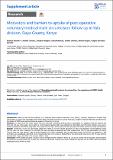Motivators and Barriers to Uptake of Post-operative Voluntary Medical Male Circumcision Follow-up in Yala Division, Siaya County, Kenya
View/
Publication Date
11/26/2016Type
Article, Journalviews
downloads
Metadata
Show full item recordCitation
The Pan African Medical Journal. 2016;25 (Supp 2):7
Abstract/
Introduction: follow-up visits are recommended to all voluntary medical male circumcision clients (VMMC), however, adherence is variable. High lost-to-follow-up cases limit knowledge about clinical status of clients and adverse events. This study sought to establish Motivators and Barriers to the Uptake of VMMC post-operative follow-up services in Siaya County, Kenya. Methods: 277 clients from five VMMC sites in Yala were recruited immediately post-operation to participate in a telephone interview between the 21st and 31st day post-surgery during which a semi-structured questionnaire was administered. Descriptive and inferential statistics was used to analyse quantitative information using SPSS while responses from open ended questions were grouped into themes, sieved out, coded and analyzed. Results: 137(49.5%) of the 277 participants utilized the follow-up services. Health education (31.4%) and emergency reviews/adverse events (24.1%) were the main motivation for returning for follow-up while occupational and other engagements (29.7%) and presumption of healing (24.6%) were the main barriers. Type of facility attended (p=0.0173), satisfaction with the discharge process (p=0.0150) and residency in Yala (p<0.001) were statistically significant to the respondents’ return for follow-up. 85(62.0%) of the participants returned on the 7th day, 9(6.6%) returned after 7 days, and 43(31.4%) returned before 7 days. Conclusion: VMMC health education should include and emphasize the benefits of follow-up care to the clients and the providers should address the barriers to accessing follow-up services. Our results will inform the programme on areas identified to improve care for VMMC clients and reduce subsequent lost-to-follow-up cases.
Subject/
Barriers; Motivators; Voluntary medical male circumcision; Post-operative follow-up
Further Details
© Bonface Abunah et al. The Pan African Medical Journal - ISSN 1937-8688. This is an Open Access article distributed under the terms of the Creative Commons Attribution License (http://creativecommons.org/licenses/by/2.0), which permits unrestricted use, distribution, and reproduction in any medium, provided the original work is properly cited.
Publisher
Pan African Medical JournalISSN
1937-8688Series
Strengthening health systems in communities: the experiences of AMREF Health Africa;Supp. 2: 7Collections
- General - GEN [367]

